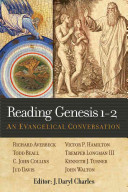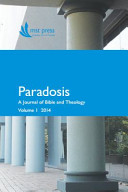Prior to reading his Discovering Genesis: Content, Interpretation, Reception (Discovering Biblical Texts; Grand Rapids: Eerdmans, 2015), I knew of Provan chiefly from I. Provan, V. Phillips Long, and Tremper Longman III, A Biblical History of Israel (Louisville/London: Westminster John Knox, 2003). Knowing that to be a quite conservative work on Old Testament history, though theoretically substantial, I was half expecting one of those commentaries on Genesis that borders on fundamentalism. The classic marker in my mind of the kind of naively conservative approach I have in mind is not a young-earth creation, which is almost non-existent in Genesis commentaries outside of the old example of Henry Morris’s The Genesis Record (1976) and what might be its intended replacement from the creationism movement, Jonathan Sarfati’s The Genesis Account (2015), a definite improvement over its predecessor. The marker that comes to mind for me is the assumption, sometimes expressed as a kind of shibboleth that does not even need supporting argument, that because the Pentateuch is traditionally deemed “the Law of Moses,” that Moses naturally wrote 99.9% of the whole five-book set, all the way back to Genesis 1:1. How could we tell that? At the least, it shouldn’t just be stated as if it needs no verifying data. That’s plain assertion, a habit we try to wean our students away from in theological education.

Right, so I was pleased to find that unsupported assertions of that kind did not characterize Provan’s book on Genesis, nor a kind of thoughtless traditionalism. My impression was that he had actually read the scholarship on the chapters he covered, which I found refreshing. He is (trusting Wikipedia on this one) 61 years old, and you get the feeling of a fair career’s worth of mature biblical reflection in this book. I didn’t agree with everything, of course; I’m still a little wary of that rather ancient Jewish position that the first-created human in Genesis 1–2 should be viewed as hermaphrodite (both male and female) until it is split into two sides and made into male & female in Gen. 2:21, a position Provan takes (p. 77). What did I like, then? Well, as an exegete by nature, I like it when a biblical commentator doesn’t let their pre-existing theology blinker them from seeing what the language of the text is actually trying to say. That happens too, I can testify. Provan calls it as he sees it, and I think he often sees it true, e.g.:
- He does not offer a great deal of theoretical explanation of the value of reception history, or to use a narrower term, the history of interpretation of Genesis 1–11, but he devotes two whole chapters to surveying this history in both Jewish and Christian interpretation, implying the importance of this tradition of interpretation for providing a context for our own reading of Genesis. By labelling these chapters “Strategies for Reading” and locating them prior to his own exegetical efforts, he rightly implies that we do not read our Bibles in a hermeneutical vacuum, but are deeply influenced by the way others, especially in our own ancestral spiritual traditions within the church, have read their Bibles before us. This is an interpretive reality to which it is easy to be blind until we study that interpretive past for ourselves. [This was the topic of my doctoral studies, so I’m sympathetic to the position. See my The Days of Creation, now a Brill title through no real merit of my own, just a providential publisher buy-out.] While we certainly will not want to imitate every past interpretive stance we discover through such a study, and many have been rendered redundant as thinking has moved on, we nevertheless sometimes find that when we read some examples of past interpretation we are looking at ourselves in the mirror.
- He can tell the difference between the age of the earliest original components of the text and the age of the final edition, done up, as I like to say, for the ‘box set’ of the Pentateuch. Indications are that most of our OT books did not arise in a single authorial setting. (Check out Karel van der Toorn, Scribal Culture and the Making of the Hebrew Bible for a few insights on the process.) This is not to presume the source criticism that classically manifested in the ‘Documentary Hypothesis’ of the Pentateuch, and Provan clearly does not sign up to that (pp. 35-37, 44). Nevertheless, materials in Genesis persist from all different times, says Provan. “[S]uppose that (as seems likely) the Genesis tradition, albeit rooted in much earlier times, was receiving its final shape during the sixth and fifth centuries BC; what may we say about the historical, social and religions context…of that time…?” (p. 50). A few pages down, he implicitly retains the value of the literal sense of the Genesis text, adding,
“If the literal sense…is of primary importance in understanding what the book of Genesis has to say, then that literal sense is intrinsically bound up with the historical, social and religious context in which the book [note, not the stories and other materials within it] first came to be, which I am taking to be the ‘axial age’ of the sixth and fifth centuries BC,” offering “a distinctive Mosaic Yahwist response to the ‘old religion’ of the a.N.E.” (p. 58).
- He points out quite rightly that the doctrine of the Fall seems to be overplayed sometimes in relation to the Genesis text. I’m not putting up my hand to be a Pelagian here, but Provan points out that even outside the Garden of Eden, God encounters Cain (with a warning) and will go on to encounter others in the story, though we might add, mostly within the framework of covenant privileges. The alienation between God and humans is not complete, though serious. For sheer honesty to the Old Testament, I rejoiced to read, “the remainder of the OT does not view the events of Genesis 3 as cataclysmic events that somehow inevitably change everything about the world in which we live. Indeed, the rest of the OT does not ever again even refer back to the events of Genesis 3 as important for human beings in the present” for understanding our relationship to the world or to God (94). This isn’t the last word on a biblical doctrine of sin, but as far as it goes, it is absolutely true (the reference to Adam in Hosea 6:7 being rather uncertain, but probably a place name). This is an issue of biblical ‘framing’; it is Paul in the New Testament who gives a whole new level of emphasis to the primordial realities of Genesis 1–3; references to the details of the Eden narrative are by contrast extremely rare in the OT.
- He identifies a curious double property of the narratives in Genesis 1–11 (pp. 95–98) that I have long sought to find the best way to explain to my students. The property is that on the one hand these narratives combine a kind of universality, e.g. presenting Adam & Eve as the parents of all humanity, the flood as eliminating all life ‘under heaven’ except what is saved on the ark, the table of nations covering all known peoples, etc. (95). But on the other hand, we not only have Cain marrying a wife (famously), but on the run, afraid he’ll be killed as a vigilante, and founding a ‘city’…for whom? Himself, his wife, and a couple of kids? I thought a three-bedroom place was roomy enough. A whole city seems positively indulgent, even if that word really means a walled settlement. Provan adds the point about the ‘nephilim’ showing up before and then after the Flood (Num 13:33; Deut. 2:11, 20), though on their way out (97). All that swimming, perhaps. I explain Genesis 1–11 as being like the Tardis from Dr. Who – obviously circumscribed in scope from the outside (e.g. covering just known ancient Near Eastern peoples in the Table of Nations in Genesis 10) while being vast almost to limitlessness, i.e. deliberately universal, on the inside. Glad to see both Provan and, in several quotations, Walter Moberly in his The Theology of the Book of Genesis (2009) picking up on this property of Genesis.

- He finds the figure of Judah nearly as important (on p. 40, he says more important) as the figure of Joseph in what we are used to thinking of as the Joseph stories (pp. 185–188). Joseph in some sense is righteous or blessed from the start. But Judah finds redemption through his offer of himself as a substitutional sacrifice (Gen. 44:18–34), and the brothers are subsequently reconciled. I fully agree with Provan. To read these chapters as essentially a biography of Joseph is not only to ignore Genesis 38 but to largely miss the point of the whole story.
I’ve picked up on some of the more noticeable positions where Provan shakes up the scene a little from a conservative evangelical point of view. In other ways, he is found taking up some more expected positions. But I have been very attracted to his scholarship and independence of mind and sheer honesty to the testimony of the text. At the same time, at under 200 pages, this is a very manageable book — deep and thoughtful, exegetically capable, but not overwhelming in size or cost. Highly recommended.



